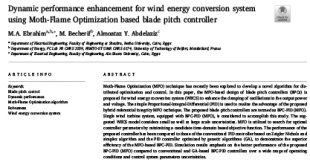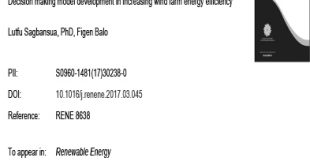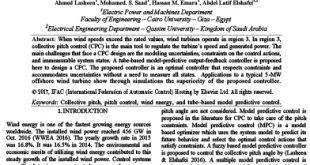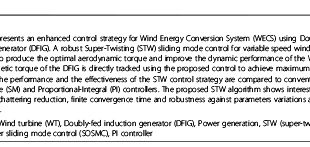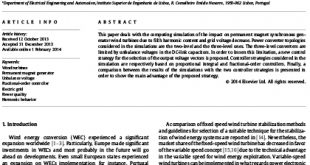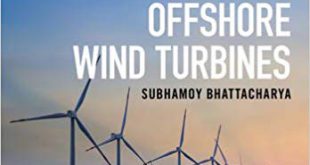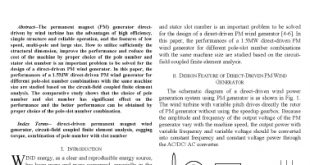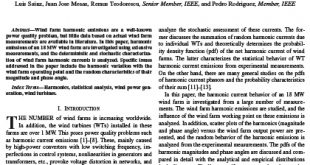Wind energy source (WES) is one of the most prominent sources of electrical energy in years to come. WES. as a renewable source. has no impacts on the climate issues and greenhouse gases (GHG) emissions. The increasing concerns about environmental problems demand green. renewable. and sustainable ideas. Wind turbines along …
Read More »Decision making model development in increasing wind farm energy efficiency
Renewable energy is a significant input for environmental. economic and social development. The wind energy has become the quickest thriving renewable energy resource. It is worth noting that wind power has the least emissions and lowest water consumption. but it has comparatively high costs. Thus. making wind energy station planning …
Read More »Robust Model Predictive Control for Collective Pitch in Wind Energy Conversion Systems
Wind energy is one of the fastest growing energy sources worldwide. The installed wind power reached 456 GW in Oct. 2016 (WWEA 2016). The yearly growth rate in 2015 was 16.8%. It was 16.5% in 2014. The environmental and economic merits of utilizing wind energy contributed to this steady growth …
Read More »Comparative study of three types of controllers for DFIG in wind energy conversion system
This paper presents an enhanced control strategy for Wind Energy Conversion System (WECS) using Doubly-Fed Induction Generator (DFIG). A robust Super-Twisting (STW) sliding mode control for variable speed wind turbine is developed to produce the optimal aerodynamic torque and improve the dynamic performance of the WECS. The electromagnetic torque of …
Read More »Fatih Birol Predicts 200 Gigawatts Of Offshore Wind By 2040
Wind energy is re-shaping the global energy mix.
Read More »Wind Energy: Renewable Energy and the Environment
The utilization of wind power and other renewable energy sources has been growing at a phenomenal rate. Wind Energy. Third Edition explores the wind industry from its inception in the 1970s to today. presents the design. aerodynamics. operation. control. applications. as well as different types of wind turbines. An overview of energy …
Read More »Fifth harmonic and sag impact on PMSG wind turbines with a balancing new strategy for capacitor voltages
The new formulation for the electrical modeling of the three-level converter combined with the new control strategy reveals the capability in mitigating the unbalancing between the capacitors bank voltages. The THD of the output current with the two-level converter and with the three-level converter have propensity to be decremented with …
Read More »Design of Foundations for Offshore Wind Turbines
As the demand for “green“ energy increases the offshore wind power industry is expanding at a rapid pace around the world. Design of Foundations for Offshore Wind Turbines is a comprehensive reference which covers the design of foundations for offshore wind turbines. and includes examples and case studies. It provides …
Read More »Choice of Pole-Slot Number Combination for PM Generator Direct-Driven by Wind Turbine
Based on comparative study on different pole-slot number combinations and pole-arc coefficients for the 1.5MW directdriven PM wind generator. the following conclusions can be deduced: 1) The pole-slot number combination has significant effect on the positioning torque at no load. Choosing the fractional slot number per pole and per phase …
Read More »Deterministic and Stochastic Study of Wind Farm Harmonic Currents
In this paper. the harmonic emissions of a 30 × ۶۰۰ kW WT SCIG wind farm are analyzed using field measurements to contribute to the understanding of wind farm harmonic behavior. The following conclusions can be drawn from the investigation. 1) Low-order characteristic harmonics are the dominant ones in the …
Read More » Iran Energy News Oil, Gas, Petrochemical and Energy Field Specialized Channel
Iran Energy News Oil, Gas, Petrochemical and Energy Field Specialized Channel
